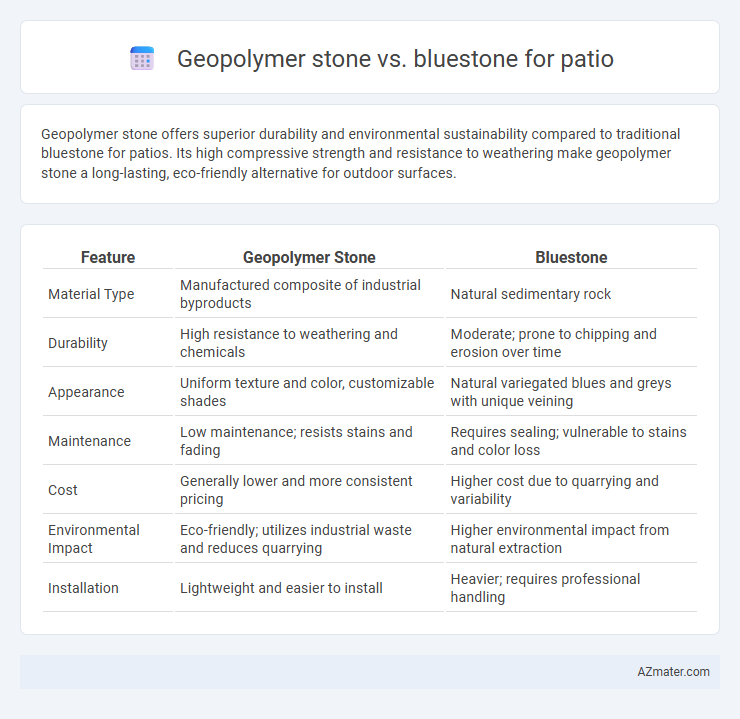Geopolymer stone offers superior durability and environmental sustainability compared to traditional bluestone for patios. Its high compressive strength and resistance to weathering make geopolymer stone a long-lasting, eco-friendly alternative for outdoor surfaces.
Table of Comparison
| Feature | Geopolymer Stone | Bluestone |
|---|---|---|
| Material Type | Manufactured composite of industrial byproducts | Natural sedimentary rock |
| Durability | High resistance to weathering and chemicals | Moderate; prone to chipping and erosion over time |
| Appearance | Uniform texture and color, customizable shades | Natural variegated blues and greys with unique veining |
| Maintenance | Low maintenance; resists stains and fading | Requires sealing; vulnerable to stains and color loss |
| Cost | Generally lower and more consistent pricing | Higher cost due to quarrying and variability |
| Environmental Impact | Eco-friendly; utilizes industrial waste and reduces quarrying | Higher environmental impact from natural extraction |
| Installation | Lightweight and easier to install | Heavier; requires professional handling |
Understanding Geopolymer Stone and Bluestone
Geopolymer stone is an engineered material made from industrial byproducts like fly ash and slag, offering high durability, eco-friendliness, and resistance to weathering, making it ideal for patio surfaces requiring long-lasting strength. Bluestone, a natural sandstone predominantly composed of feldspar and quartz, features unique mineral variations and a naturally slip-resistant surface well-suited for traditional patio aesthetics. Comparing both, geopolymer stone provides consistent quality and lower maintenance, while bluestone offers natural texture and color variation valued in classic landscaping designs.
Composition and Material Differences
Geopolymer stone is an engineered material created from industrial byproducts like fly ash and slag, offering enhanced durability and resistance to weathering compared to natural bluestone, which is a dense, fine-grained sandstone primarily composed of quartz, feldspar, and mica. The polymeric binding agents in geopolymer stone result in a consistent texture and color, while bluestone varies in appearance due to its naturally occurring mineral composition and layering. Geopolymer stone typically requires less maintenance and has improved environmental sustainability due to its recycled content, whereas bluestone provides a traditional aesthetic with natural variations prized in landscaping.
Aesthetic Appeal: Visual Comparison
Geopolymer stone offers a uniform texture with customizable colors that mimic natural stone, providing a modern and sleek aesthetic for patios. Bluestone features rich, varied hues of blue-gray with natural veining, delivering a classic, rustic charm and timeless beauty. Both materials create distinct visual appeals: geopolymer stone suits contemporary designs with consistent finishes, while bluestone enhances traditional patios with organic, natural patterns.
Durability and Weather Resistance
Geopolymer stone offers exceptional durability and superior resistance to weathering compared to traditional bluestone, making it ideal for patio applications in harsh climates. Its synthetic composition ensures minimal absorption of water, reducing risks of cracking and erosion caused by freeze-thaw cycles. Bluestone, while naturally strong, is more porous and prone to surface wear, requiring regular maintenance to preserve its appearance and structural integrity over time.
Installation Process and Versatility
Geopolymer stone offers a lighter weight and easier cutting process compared to natural bluestone, significantly reducing installation time and labor costs. Bluestone, while durable and visually striking, often requires specialized tools and skilled labor due to its density and irregular thickness, making installation more complex. Geopolymer stone's uniformity and customizable shapes provide greater versatility for intricate patio designs, whereas bluestone's natural variation adds unique character but limits design flexibility.
Maintenance Requirements
Geopolymer stone offers superior resistance to stains, scratches, and weathering, requiring minimal maintenance compared to natural bluestone. Bluestone patios need regular sealing, cleaning, and occasional repairs to prevent erosion and discoloration from moisture and outdoor elements. Choosing geopolymer stone reduces long-term upkeep costs and preserves the patio's appearance with less effort.
Environmental Impact and Sustainability
Geopolymer stone offers a significantly lower carbon footprint compared to traditional bluestone due to its use of industrial byproducts like fly ash, reducing reliance on natural quarrying. Bluestone, while durable, involves energy-intensive extraction processes that disrupt ecosystems and generate substantial greenhouse gas emissions. Choosing geopolymer stone for patios supports sustainability by minimizing environmental degradation and promoting recycled material utilization.
Cost Comparison: Geopolymer Stone vs Bluestone
Geopolymer stone typically costs 30-50% less than natural bluestone, making it a budget-friendly choice for patio installations. Production of geopolymer stone uses industrial byproducts like fly ash, reducing material expenses compared to the quarrying and extraction costs of natural bluestone. While natural bluestone's price fluctuates with availability and regional demand, geopolymer stone offers consistent pricing and lower installation costs due to its lighter weight and easier cutting properties.
Suitability for Various Patio Designs
Geopolymer stone offers exceptional versatility for patio designs due to its customizable colors and textures, making it ideal for modern and contemporary outdoor spaces. Bluestone, known for its natural blue-gray hues and durability, suits traditional and rustic patio aesthetics, providing a timeless appeal. Both materials withstand weathering effectively, but geopolymer stone's lightweight nature enhances ease of installation across diverse patio layouts.
Pros and Cons Summary
Geopolymer stone offers high durability, low maintenance, and eco-friendly manufacturing with strong resistance to weathering but may have higher initial costs and limited color variety. Bluestone provides natural beauty, excellent slip resistance, and extensive color options, while it requires regular sealing and can be prone to chipping and weather-related wear. Choosing between geopolymer stone and bluestone depends on budget, aesthetic preferences, and long-term maintenance commitment for patio installations.

Infographic: Geopolymer stone vs Bluestone for Patio
 azmater.com
azmater.com